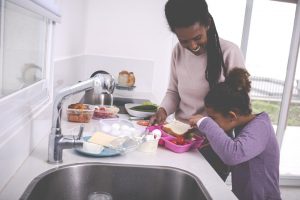
With the appearance of COVID-19, many guidelines and laws across the states are changing. School administrators, teachers, parents and grandparents are working to supply food for children in a safe and healthy manner. Part of establishing and maintaining good health is making healthy food choices. Eating nutritious foods impacts children’s health, as well as their mood, development and ability to learn and focus more in school and at home. One option many families are considering is packing meals for each child. This can increase the workload for parents, so here are some tips for planning, preparing and packing quick and healthy lunches.
· Preparing in advance – to save time use weekends and weeknights to prepare food. Instead of store-bought snacks, try homemade chips made from kale, eggplant, potatoes or squashes for a healthier alternative. Consider buying snack items that are already individually packaged and can be bought in bulk or plan to pack them up yourself in advance. For example, chips, popcorn, nuts, fruits, vegetables, yogurt, cheese, crackers, pretzels, a sweet treat, etc.
· Fruits and vegetables a great way for children to get fiber, minerals and vitamins that they need to function well. There are all sorts of ways to get children to try fruits and vegetables – fresh, dried, in yogurts, smoothies, granola and many more. Some healthy and easy-to-travel options include oranges, apples, bananas, grapes, carrots, celery, broccoli, and berries. Oftentimes whole fruits pack better and are easier to add to a lunch.
· Sandwiches are simple and cost-efficient lunch options. For example; peanut butter and jelly, peanut butter and banana, tomato, meat and cheese, etc. If your child suffers from an allergy there are many alternatives, such as sunflower seed butters. You can use bread, tortillas, wraps, buns, and lettuce as the outside layer. Many ingredients can be purchased from the store. Children can also learn the basics of cooking by making their own sandwiches. Fun fact – children who help make their own food are twice as likely to eat it, and it only increases if they help grow it too!
· Pizza can be considered as a good option for a lunch item because it combines multiple food groups in one meal meeting nutritional needs. Leftover pizza from a previous meal is easy to pack up and can be eaten hot or cold. Children can accessorize the toppings on their pizzas. Get creative by alternating your ingredients with – traditional crusts, tortillas, English muffins, pita bread, or biscuits. You can make your own pizza puffs by flattening some biscuit dough and placing all pizza ingredients in the center and sealing it off with a quick pinch of your fingers. While this takes more time to prepare, you can make more crusts and pizzas at a cheaper cost than buying them premade. Another option is using crackers, pepperoni slices and sliced cheese to make a mini pizza sandwich. These options provide bonding time through hands-on lessons on math and science as children learn the art of cooking and baking.
· Tuna salad, chicken salad, egg salad or pasta salads are also options that can be made in advance and quickly paired with wraps, crackers or a piece of bread.
· If you’re looking for even healthier options, and children aren’t picky, salads travel well and make for very nutritious lunches. Wash and prepare vegetables earlier in the week and store in airtight containers. These are quickly assembled and provide an abundance of nutrients and vitamins.
· For a themed lunch, you can also do a “breakfast lunch box” and include cereal, milk, hard-boiled eggs, granola bars, bagels, or muffins. Pairing these breakfast goodies with some fresh fruit is a great way to get some sweetness into their meal without added sugars.
Be sure to talk with friends, neighbors and family members to see what other quick and easy lunches you can pack for your children. And don’t forget to take food safety precautions to make sure a lunch is packed to keep cold foods cold where necessary.
Contributor
Sarah Ransom – University of Tennessee Family and Consumer Sciences Extension Agent
